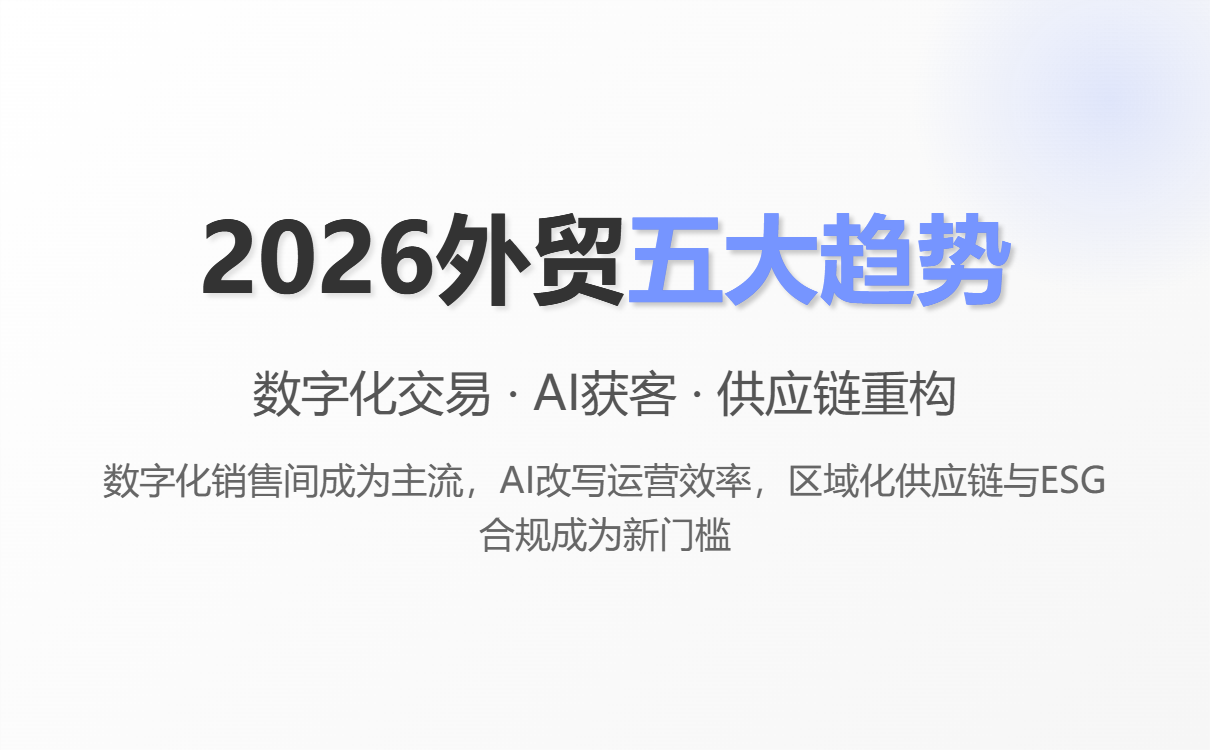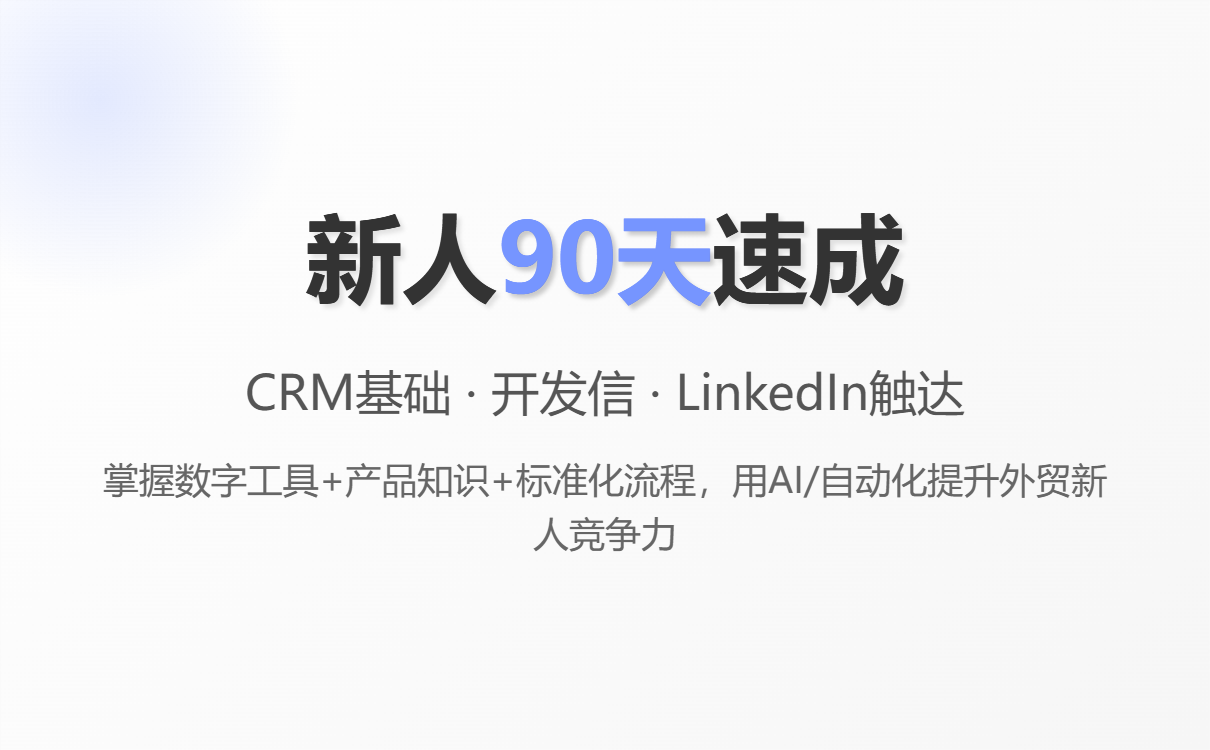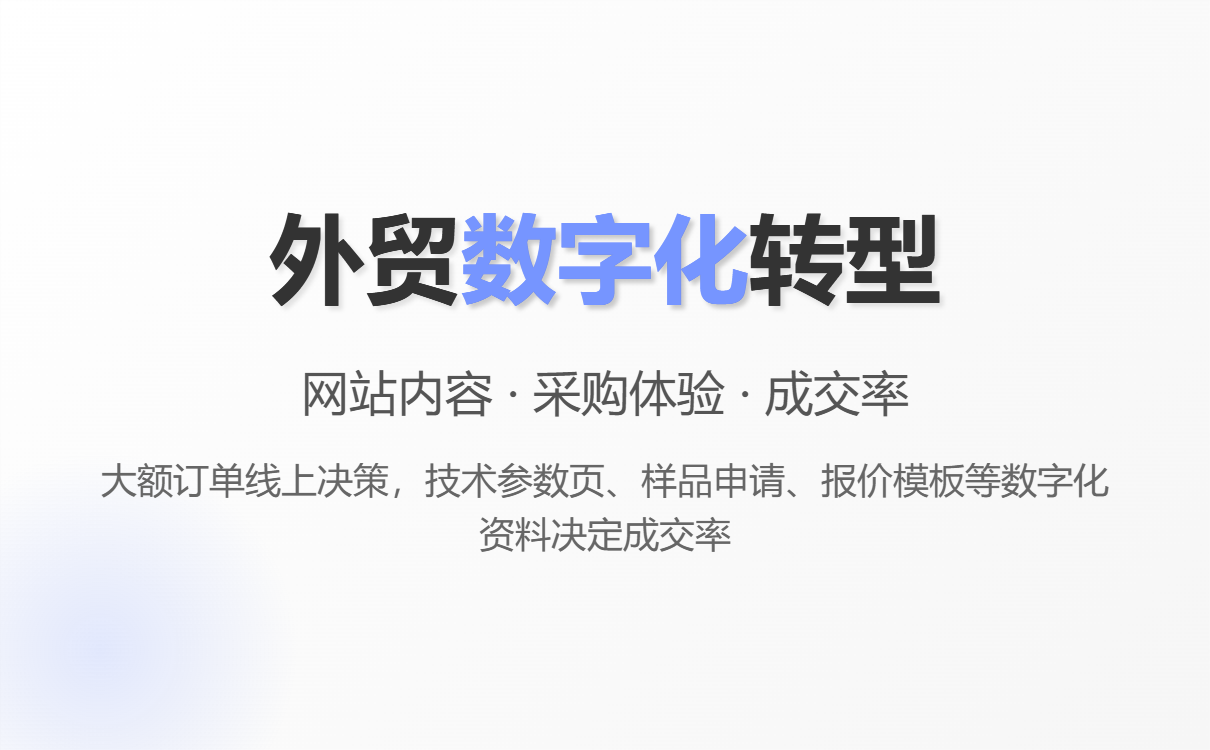
Global merchandise trade rebounded in 2025, driven by AI-related equipment and "pre-emptive stockpiling by the US." However, the WTO has lowered its 2026 global merchandise trade growth forecast and warned of significant uncertainty—for B2B foreign trade, "structural opportunities coexisting with cyclical risks" is the new normal. Recommended reading: A Newcomer's Hard-Won Summary: A Complete Guide to Free and Paid Customer Development Channels (Personally Tested Path to Explosive Orders)

A Gartner industry report indicates that by 2026, an increasing number of complex B2B transactions will occur in digital sales rooms and online self-service channels, where buyers complete most of their decisions through online materials, content, and automated communication before placing an order. For suppliers, this means that the website/content/digital sourcing experience directly determines the conversion rate .
Practical insights : Complete the web pages and digital materials that "can generate trust and drive the next step" (technical parameter page, sample application, quotation template, FAQ, compliance certificates, logistics timetable).
McKinsey and several consulting firms indicate that businesses will continue to embed AI into their sales and marketing processes, from lead scoring to automated follow-up, from content generation to procurement forecasting. AI can simultaneously reduce labor costs and closing cycles. Companies adopting AI will have a clear advantage in efficiency and conversion rates.
Practical insights : Prioritize turning repetitive tasks (quotation response templates, A/B marketing emails, follow-up tracking, sample production) into semi-automated processes using AI/automation; adopt a hybrid "human + AI" approach as the initial strategy.
Geopolitical and tariff policies have led to a coexistence of "nearshore/regional supply" and diversified sourcing; meanwhile, the predictability of cross-border logistics and customs clearance has become a selling point. Sellers who can provide clear solutions for logistics/warehousing/compliance will be more popular than those who only offer "low-priced goods".
Practical tips : Clearly indicate on the product page: shortest delivery time, common port/warehouse options, supported customs documents, and return/exchange policy.
ESG and compliance considerations are increasingly integrated into the customer procurement process, specifically into the Request for Proposal (RFP) and supplier selection. Suppliers lacking compliance documentation (materials, chemical certificates, social compliance) are directly filtered out.
Practical tips : Prepare commonly used compliance certificates (ISO, RoHS, MSDS, Certificate of Origin, etc.) and display them digitally with quick download functionality in a prominent position on your website.
The boundaries between cross-border retail e-commerce and B2B channels are blurring: social content, short videos, and professional communities can all generate B2B leads; logistics and payment experience remain key conversion factors. Data from logistics providers such as DHL also indicates that cross-border purchasing intentions (price/timeliness/trust) are continuously rising.
Practical insights : Create "product + solution" content on LinkedIn/YouTube/industry communities, and use it in conjunction with a landing page (including a quote entry) to generate traffic and leads.
Conclusion : Opportunities exist, but newcomers should focus on "rapidly learning digital tools + deepening product knowledge + executing standardized processes" as core competencies. Data and trends show that businesses are increasingly reliant on digital touchpoints and automated processes. Newcomers who are proficient in CRM, writing conversion-oriented sales emails, and using website and content tools can achieve results in a short period.
5 Essential Skills for Beginners (90-Day Crash Course Checklist) :
CRM Basics ( AB Customer CRM is free to use; import leads, record follow-up, and set up automatic reminders )
Able to write three types of development documents: initial contact emails, sample invitations, and quotation confirmations (using templates).
Proficient in using an independent website's management backend (uploading products, editing landing pages, and viewing traffic sources).
They use LinkedIn to create customer profiles and launch targeted outreach.
Basic Negotiation and Contract Terms (Payment, MOQ, Delivery Date, Inspection)

Product/Specification Database: Each SKU has 1 page of standard information (parameters, weight, packaging, minimum order quantity, FOB/EXW/DOOR).
Digitalization of compliance certificates: PDF archiving with the ability to generate temporary public links.
Quotation template: Divided into different payment and quantity categories, with an automatically calculated spreadsheet (Excel/Google Sheets + template).
Standard sample process: Who applies, who pays (shipping/customs), sample delivery schedule
Website Building + Multilingual Support: Establish an independent website (multilingual, mobile-first), coupled with SEO and a content library. The "Foreign Trade B2B Intelligent Marketing Solution" automates these processes. ABKe Intelligent Website Builder offers one-click website launch and multilingual website group support, quickly generating a tradable corporate website. https://www.cnabke.com
Note: Independent websites are long-term assets that can convert online leads into manageable CRM records.
LinkedIn targeted outreach: 20 targeted invitations per day (industry + job + region), with a personalized one or two-sentence opening.
Content Seed Method: Publish one "pain point solution" article or video every week (sample process, case study, controllable delivery time explanation), and include a form on the landing page.
Industry vertical platforms/marketplaces: Utilize industry B2B marketplaces and procurement databases to place samples or small-batch trial orders.
SEO and long-tail pages: Create special pages around "products + solutions" (e.g., "temperature resistance solutions for mechanical seals + industrial customer case studies").
Fast Track : A paid package (LinkedIn Ads + Google/Bing Keywords + Landing Page) is used to catalyze the initial 3 months of the business.
Value-first follow-up method: The first follow-up is to send "sample display/performance short video + delivery date guarantee", the second follow-up is to send "quotation + MOQ tiers", and the third follow-up is to send "CIF/logistics solution".
Automated follow-up sequence: CRM sets out 1, 3, 7, and 14-day outreach templates (email + WhatsApp/LinkedIn) and labels them with customer interest levels.
Sample strategy: Start with small orders → deliver in stages → expand orders (Risk Hedge strategy)
Price negotiation tactics: Negotiate based on "Total Cost of Ownership (TCO)" rather than the bare price, highlighting the advantages of transportation, returns, and warranty.
Standard sales contract templates (payment terms, extensions, inspection terms, force majeure) are uploaded to the cloud and can be quickly sent to customers for signing.
Multiple payment options (letter of credit, TT, intermediary payment, third-party guarantee) are available, tiered according to customer risk.
Small customer priority matrix: For the first cooperation, the risk is controlled within the limit of 1 sample/trial order amount, and the incentive for repeat purchase is written into the contract.
Segmented inspection: small batches are shipped first, and the remaining quantity is shipped after the first batch passes inspection.
After-sales SLA: Clearly define the response timeframe (within 24 hours) and include the most frequently asked questions in the FAQ.
Case Study Library: Each successful delivery generates a case study page (with images and the client's agreed-upon wording) for future customer acquisition.
Website/Website Building : ABke Intelligent Website Builder (Multilingual + AI-powered Content Writing + SEO Automation) — Used to build landing pages and website clusters for "International Trade B2B Intelligent Marketing Solutions". https://www.cnabke.com
CRM/Automation : HubSpot (start with free), Pipedrive, enable email automation and follow-up tasks.
Content/AI Tools : Generative AI is used to create initial drafts (developer emails/product descriptions/FAQs), which are then manually proofread before being uploaded to the website.
Payment/Settlement : Wise, bank wire transfer, letter of credit, third-party factoring platform (select according to customer and amount).
Logistics/Customs Clearance : DHL/FedEx/Regional Freight Forwarder (Common Port Delivery Times listed).
Lead Acquisition Cost (CAC)
Website visitor → lead conversion rate (target 2-6% starting point, may vary depending on industry)
Lead to Opportunity Conversion Rate (Target 5–15%)
Average time from opportunity to transaction (days)
Use this data to review weekly and adjust landing page, email templates, and sample strategies.

Days 1–3: Prepare materials (product page, sample period, minimum order quantity)
Days 4–7: Create a LinkedIn profile, send out 60 targeted invitations, and prepare three versions of outreach email templates.
Days 8–14: 20 outreach messages per day + process each response and add qualified leads to the CRM follow-up sequence (sample requests given priority).
Days 1–4: Building a landing page for a special topic + SEO basics + Sample workflow chart
Days 5–10: Small-scale paid lead generation testing (LinkedIn/Google) + A/B outreach emails
Days 11–14: Import the first batch of leads into the CRM, follow up twice, and conduct a debriefing.
Days 1–7: Select 1–2 key products, launch them on the website (multilingual), and upload compliance certificates.
Days 8–20: Integrating CRM and automation, configuring sample workflows, and starting content production (2 articles per week).
Days 21–30: Small-batch paid customer acquisition + conversion testing, optimization and standard operating procedure (SOP) development.
Tip: The enterprise version can directly use ABke Smart Website Builder to quickly implement "from website building to content to SEO", saving time on technical and operational integration.
Q1: Should I build an independent website or join a B2B platform?
A: Both can be done in parallel. An independent website is a long-term asset (trust + SEO + lead management), while a platform facilitates rapid traffic and transaction testing; driving platform traffic back to the independent website for relationship building and repeat purchases is a better strategy.
Q2: How can I quickly build trust when I first start out in the industry?
A: Transparent compliance documentation, rapid sample response, a detailed delivery process, and verifiable physical samples/videos for customers can quickly build trust. Highlight these on the website's homepage and in the sample process section.
Q3: Will AI take my job?
A: AI will replace repetitive tasks, but more importantly, "whoever knows how to use AI can make deals more efficiently." Treat AI as a tool and spend your time on customer relationships and solutions.
Risk: Global trade growth slowdown (cyclical) → Countermeasures: Product and market diversification, reducing dependence on a single market.
Risks: Geopolitical and tariff uncertainties → Countermeasures: Prepare price terms, delivery commitments, and alternative supply chain nodes.
2026 is not a year to wait for a "recovery," but a year to "reconstruct competitiveness." Newcomers can quickly establish themselves in the foreign trade B2B market by mastering digital tools, implementing standardized processes effectively, and excelling in the three key areas of "product + solution + trust." The most pragmatic approach is to use "foreign trade B2B intelligent marketing solutions" as a business model, treat independent websites (such as those built with ABK Intelligent Website Builder ) as long-term assets, and use content and LinkedIn to drive traffic and AI automation to improve efficiency in the short term .
.png?x-oss-process=image/resize,h_100,m_lfit/format,webp)
.png?x-oss-process=image/resize,h_100,m_lfit/format,webp)

.png?x-oss-process=image/resize,h_100,m_lfit/format,webp)
.png?x-oss-process=image/resize,h_100,m_lfit/format,webp)
.png?x-oss-process=image/resize,h_100,m_lfit/format,webp)
.png?x-oss-process=image/resize,h_100,m_lfit/format,webp)
